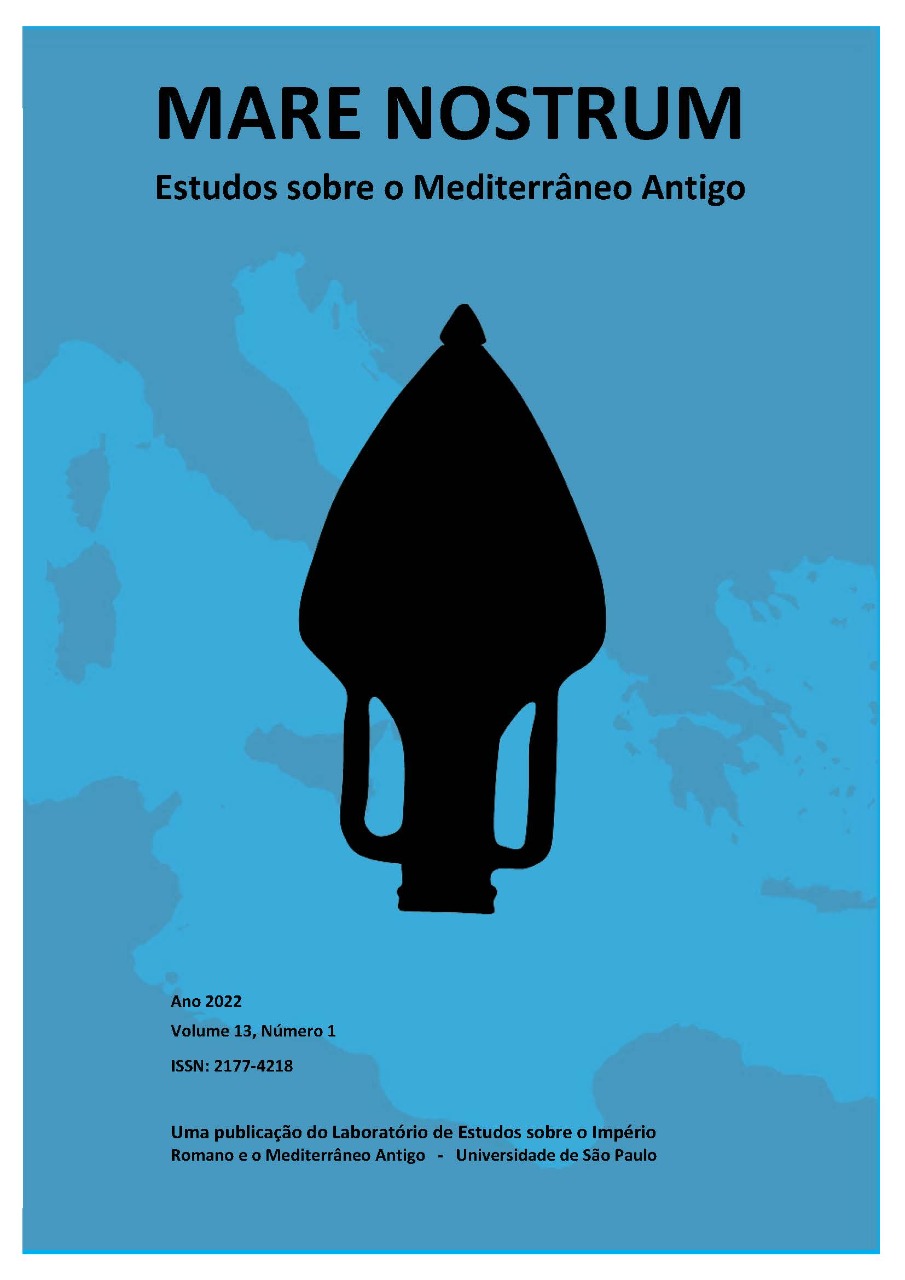Writing, Sealing, and Managing. An approach to the documentary sources of the Third Dinasty of Ur from the Landscape Ephigraphy
DOI:
https://doi.org/10.11606/issn.2177-4218.v13i1p219-250Keywords:
Landscape Epigraphy, Mesopotamia, Third Dynasty of Ur, administrative textsAbstract
In this article, we propose an approach to the administrative texts of the Third Dynasty of Ur in Mesopotamia (c. 2110-2003 BCE) – in particular, of the pisaĝ-dub-ba tablets – from a theoretical-methodological perspective that we will call Landscape Epigraphy. On the one hand, its importance lies in understanding documents in the same contexts of production, circulation, and storage, considering their semantic-internal and syntactic-structural components. On the other, it enables the understanding and recognition, based on a rigorous approach to administrative documentation, of (i) agents (human and non-human) along with their practices, (ii) objects/things (material culture), and (iii) places involved in shaping a social landscape. In the case of Lower Mesopotamia, the social landscape was composed of several provincial archives, which were subdivided into smaller and larger offices as regulators of different economic and political spheres of this period. Finally, the outlined theoretical-methodological perspective will contribute to the analysis of the Neo-Sumerian bureaucratic system, which would have been expressed through the messages contained in the documentary record and, in this way, it reinforced the legitimate voice of the center over local powers.
Downloads
References
Appadurai, A. (1986). Introduction: Commodities and the Politics of Value. En A. Appadurai (Ed.), The Social Life of Things: Commodities in Cultural Perspective (pp. 3-63). Cambridge University Press.
Bajtín, M. (2002 [1979]). Estética de la creación verbal. Siglo XXI.
Cammarosano, M. (2014). The Cuneiform Stylus. Mesopotamia, 49, 53-85.
Chapman, H. (2006). Landscape Archaeology and GIS. History Press.
Chartier, R. (2006). Materialidad del texto, textualidad del libro. Orbis Tertius: Revista de Teoría y Crítica Literaria, 11(12). Recuperado de http://163.10.30.53/ojs_viejo/index.php/OT/article/view/OTv11n12a01/3774
Chartier, R. (2015). La main de l’auteur et l’esprit de l’imprimeur, xvie-xviiie siècle (Collection Folio histoire 243). Gallimard.
Criado Boado, F. (1993). Límites y posibilidades de la Arqueología del Paisaje. Spal. Revista de Prehistoria y Arqueología, 2, 9-55.
Criado Boado, F. (1999). Del terreno al espacio: planteamientos y perspectivas para la Arqueología del Paisaje (CAPA 6). LAFC, Universidad de Santiago de Compostela.
Cripps, E. (2017). The Structure of Prices in the Neo-Sumerian Economy (I): Barley: Silver Price Ratios. Cuneiform Digital Library Journal, 2. Recuperado de http://www.cdli.ucla.edu/pubs/cdlj/2017/cdlj2017_002.html
Edzard, D.O. (1976-1980). Keilschrift. Reallexikon der Assyriologie und Vorderasiatischen Archäologie, 5, 544-568.
Garfinkle, S.J. (2005). Public versus Private in the Ancient Near East. En D.C. Snell (Ed.), A Companion to the Ancient Near East (pp. 384-396). Blackwell Publishing.
Garfinkle, S.J. (2008). Was the Ur III State Bureaucratic? Patrimonialism and Bureaucracy in the Ur III Period. En S.J. Garfinkle & J.C. Johnson (Eds.), The Growth of an Early State in Mesopotamia: Studies in Ur III Administration. Proceedings of the First and Second Ur III Workshops at the 49th and 51st Rencontre Assyriologique Internationale, London July 10, 2003 and Chicago July 19, 2005 (pp. 55-61) (BPOA 5). CSIC.
Garfinkle, S.J. (2013). Ancient Near Eastern City-States. En P. Figiber Bang & W. Scheidel (Eds.), The Oxford Handbook of the State in the Ancient Near East and Mediterranean (94-119). Oxford University Press.
Gelb, I.J. (1967). Approaches to the Study of Ancient Society. Journal of the American Oriental Society, 87, 1-8.
Gelb, I.J. (1979). Household and Family in Early Mesopotamia. En E. Lipiński (Ed.), State and Temple Economy in the Ancient Near East: Proceedings of the International Conference Organized by the Katholieke Universiteit Leuven from the 10th to the 14th of April 1978 (pp. 1-97) (OLA 5). Departement Oriëntalistiek, Katholieke Universiteit Leuven.
Glassie, H. (1969). Pattern in the Material Folk Culture of the Eastern United States. University of Pennsylvania Press.
Glassie, H. (1999). Material Culture. Indiana University Press.
Gosden, C. & Marshall, Y. (1999). The Cultural Biography of Objects. World Archaeology: The Cultural Biography of Objects, 31(2), 169-178.
Grégoire, J.-P. (1981). L’origine et le développement de la civilisation mésopotamienne du troisième millénaire avant notre ère. En C.-H. Breteau, C. Lacoste-Dujardin, C. Lefebure & N. Zagnoli (Eds.), Production, pouvoir et parenté dans le monde méditerranéen de Sumer à nos jours (pp. 27-101). Éditions Paul Geuthner.
Hernando Gonzalo, A. (1999). El espacio no es necesariamente un lugar: en torno al concepto de espacio y a sus implicaciones en el estudio de la Prehistoria. Arqueología espacial, 21, 7-28.
Hicks, D. (2010). The Material-Cultural Turn: Event And Effect. En D. Hicks & M.C. Beaudry (Eds.), The Oxford Handbook of Material Culture Studies (pp. 25-98). Oxford University Press.
Hodder, I. (2011). Human-Thing Entanglement: Towards an Integrated Archaeological Perspective. Journal of the Royal Anthropological Institute, 17, 154-177.
Jagersma, B. (2010). A Descriptive Grammar of Sumerian. Tesis de doctorado. Universiteit Leiden.
Liverani, M. (1988). Antico Oriente. Storia, società, economia. Gius. Laterza & Figli.
Liverani, M. (2013). Immaginare Babele. Due secoli di studi sulla città orientale antica. Gius. Laterza & Figli.
Meskell, L. (2005). Introduction: Object Orientations. En L. Meskell (Ed.), Archaeologies of Materiality (pp. 1-17). Blackwell Publishing
Miller, D. (2005). Materiality. An Introduction. En D. Miller (Ed.), Materiality (pp. 1-50) (Politics, History, and Culture). Duke University Press.
Miller, D. (1987). Material Culture and Mass Consumption. Blackwell Publishing.
Molina, M. (2002-) (Ed.). BDTNS. Base de Datos de Textos Neosumerios. Recuperado de http://bdts.filol.csic.es
Molina, M. (2008). The Corpus of Neo-Sumerian Tablets: an Overview. En S.J. Garfinkle & J.C. Johnson (Eds.), The Growth of an Early State in Mesopotamia: Studies in Ur III Administration (pp. 19-53) (BPOA 5). CSIC.
Molina, M. (2016). Archives and Bookkeeping in Southern Mesopotamia during the Ur III Period. Comptabilités. Revue d’histoire des comptabilités, 8. Recuperado de http://journals.openedition.org/comptabilites/1980
Nelson, R.C. (1976). Pisan-dub-ba Texts from the Sumerian Ur III Dynasty. Tesis de doctorado. University of Minnesota.
Oppenheim, A.L. (1964 [1977]). Ancient Mesopotamia: Portrait of a Dead Civilization. University of Chicago Press.
Peirce, C.S. (1931-1935). The Collected Papers of Charles Sanders Peirce, v. 2, ed. de C. Hartshorne & P.Weiss. Harvard University Press.
Piquette, K.E. & Whitehouse, R.D. (2013). Introduction: Developing an Approach to Writing as Material Practice. En K.E. Piquette & R.D. Whitehouse (Eds.), Writing as Material Practice: Substance, Surface and Medium (pp. 1-13). Ubiquity Press.
Postgate, J.N. (1992). Early Mesopotamia: Society and Economy at the Dawn of History. Routledge.
Preucel, R.W. (2006). Archaeological Semiotics. Blackwell.
Rede, M. (1996). História a partir das coisas: tendências recentes nos estudos de cultura material. Anais do Museu Paulista: História e Cultura Material, 4(1), 265-282.
Rede, M. (1999). Complexidade social, sistemas comunicativos e gênese da escrita cuneiforme. Classica - Revista Brasileira de Estudos Clássicos, 11(11/12), 37-59.
Rede, M. (2000-2001). Estudos de cultura material: uma vertente francesa. Anais do Museu Paulista: História e Cultura Material, 8(1), 281-291.
Rede, M. (2007). Família e patrimônio fundiário: notas para o estudo da economia doméstica na antiga Mesopotâmia. História e Economia. Revista Interdisciplinar, 3(1), 71-102.
Renger, J. (1995). Institutional, Communal, and Individual Ownership or Possession of Arable Land in Ancient Mesopotamia from the End of the Fourth to the End of the First Millennium B.C. Chicago Kent Law Review, 71(1), 269-319.
Richardson, S. (2014). Mesopotamian Political History: The Perversities. Journal of Ancient Near Eastern History, 1(1), 61-93.
Sallaberger, W. (1993). Der kultische Kalender der Ur-III-Zeit (Untersuchungen zur Assyriologie und Vorderasiatischen Archäologie. Ergänzungsbände zur Zeitschrift für Assyriologie und Vorderasiatische Archäologie 7/1). Walter de Gruyter Inc.
Sallaberger, W. (1999). III Dinastía de Ur-Zeit. En W. Sallaberger & A. Westenholz (Eds.), Mesopotamien: Akkade-Zeit und III Dinastía de Ur-Zeit (pp. 119-390) (OBO 160/3). Universitätsverlag Freiburg/Vandenhoeck & Ruprecht.
Sallaberger, W. & Schrakamp, I. (Eds.) (2015). History and Philology (ARCANE 3). Brepols.
Saussure, F. de. (1995 [1916]). Curso de lingüística general. Losada.
Schloen, J.D. (2001). The House of the Father as Fact and Symbol: Patrimonialism in Ugarit and the Ancient Near East (SAHL 2). Eisenbrauns.
Soja, E. (1996). Thirdspace: Journeys to Los Angeles and Other Real-and-Imagined Places. Blackwell.
Steinkeller, P. (2003a). An Ur III Manuscript of the Sumerian King List. En W. Sallaberger, K. Volk & A. Zgoll (Eds.), Literatur, Politik und Recht in Mesopotamien: Festschrift für Claus Wilcke (pp. 267-292). Harrasowitz.
Steinkeller, P. (2003b). Archival Practices in Babylonia in the Third Millenium. En M. Brosius (Ed.), Ancient Archives and Archival Traditions: Concepts of Record-Keeping in the Ancient World (pp. 37-58). Oxford University Press.
Steinkeller, P. (2004). The Function of Written Documentation in the Administrative Praxis of Early Babylonia. En M. Hudson & C. Wunsch (Eds.), Creating Economic Order: Record-Keeping, Standardization, and the Development of Accounting in the Ancient Near East. A Colloquium Held at the British Museum, November 2000 (pp. 65-88) (ISCANEE 4). CDL.
Steinkeller, P. (2013). Corvée Labor in Ur III Times. En S.J. Garfinkle & M. Molina (Eds.), From the 21st Century B.C. to the 21st Century A.D. Proceedings of the International Conference on Sumerian Studies Held in Madrid 22-24 July 2010 (pp. 347-424). Eisenbrauns.
Taylor, J. (2011). Tablets as Artefacts, Scribes as Artisans. En K. Radner y E. Robson (Eds.), Oxford Handbook of Cuneiform Culture (pp. 5-31). Oxford University Press.
Tilley, C. (1991). Material Culture and Text: the Art of Ambiguity. Routledge.
Tilley, C. (1999). Metaphor and Material Culture. Blackwell.
Tsouparopoulou, C. (2013). Reflections on Paratextual Markers and Graphic Devices in Ur III Administrative Documents. Textual Cultures, 8(2), 1-14. DOI: 10.14434/tc.v8i2.13276
Tsouparopoulou, C. (2015). Spreading the Royal Word: The (Im)Materiality of Communication in Early Mesopotamia. En S. Enderwitz & R. Sauer (Eds.), Communication and Materiality in Pre-Modern Societies (pp. 7-23) (Materiale Textkulturen 8). Walter de Gruyter Inc.
Ur, J. (2014). Households and the Emergence of Cities in Ancient Mesopotamia. Cambridge Archaeological Journal, 24(2), 249-268.
Van de Mieroop, M. (1999). Cuneiform Texts and the Writing of History. Routledge.
Veldhuis, N. (2011). Levels of Literacy. En K. Radner & E. Robson (Eds.), The Oxford Handbook of Cuneiform Culture (pp. 68-89). Oxford University Press.
Wagstaff, J.M. (Ed.). (1987). Landscape and Culture: Geographical and Archaeological Perspectives. Blackwell.
Yoffee, N. (2004). Myths of the Archaic State: Evolution of the Earliest Cities, States and Civilizations. Cambridge University Press.
Yoffee, N. y Seri, A. (2019). Negotiating Fragility in Ancient Mesopotamia: Arenas of Contestation and Institutions of Resistance. En N. Yoffee (Ed.), The Evolution of Fragility: Setting the Terms (pp. 183-196). McDonald Institute for Archaeological Research, University of Cambridge.
Zólyomi, G. (2017). An Introduction to the Grammar of Sumerian. Eötvös University Press.
Downloads
Published
Issue
Section
License
Copyright (c) 2022 Rodrigo Cabrera

This work is licensed under a Creative Commons Attribution 4.0 International License.
Responsibility for the content published by Mare Nostrum rests exclusively with the author(s) of such content.
The reproduction of the texts published by Mare Nostrum is licensed according to Creative Commons license Attribution-NonCommercial 4.0 International (CC BY-NC).
Authors who publish with this journal agree to the following terms:
- Authors retain copyright and grant the journal right of first publication with the work simultaneously licensed under a Creative Commons Attribution License that allows others to share the work with an acknowledgement of the work's authorship and initial publication in this journal.
- Authors are able to enter into separate, additional contractual arrangements for the non-exclusive distribution of the journal's published version of the work (e.g., post it to an institutional repository or publish it in a book), with an acknowledgement of its initial publication in this journal.
- Authors are permitted and encouraged to post their work online (e.g., in institutional repositories or on their website) prior to and during the submission process, as it can lead to productive exchanges, as well as earlier and greater citation of published work (See The Effect of Open Access).









